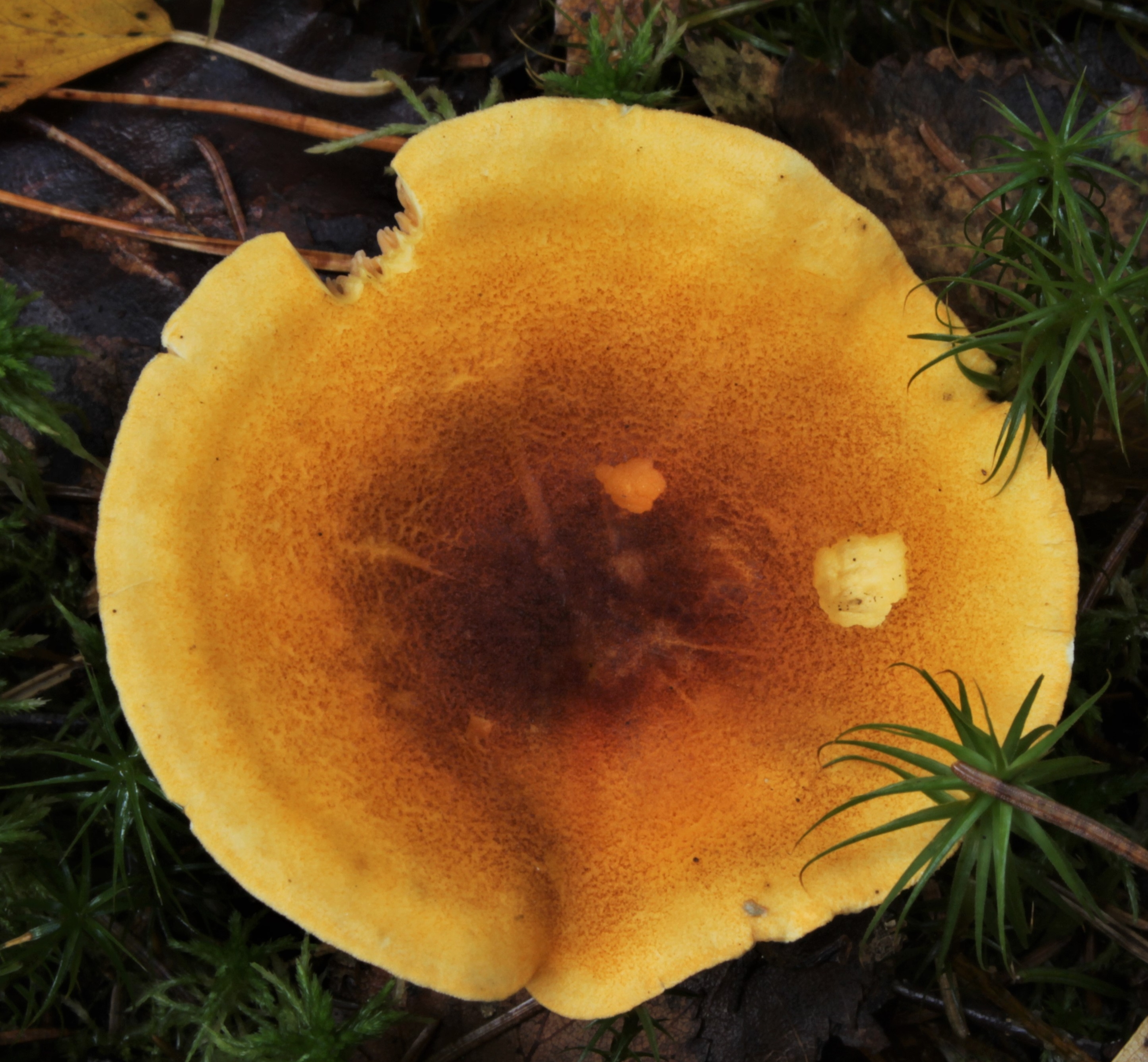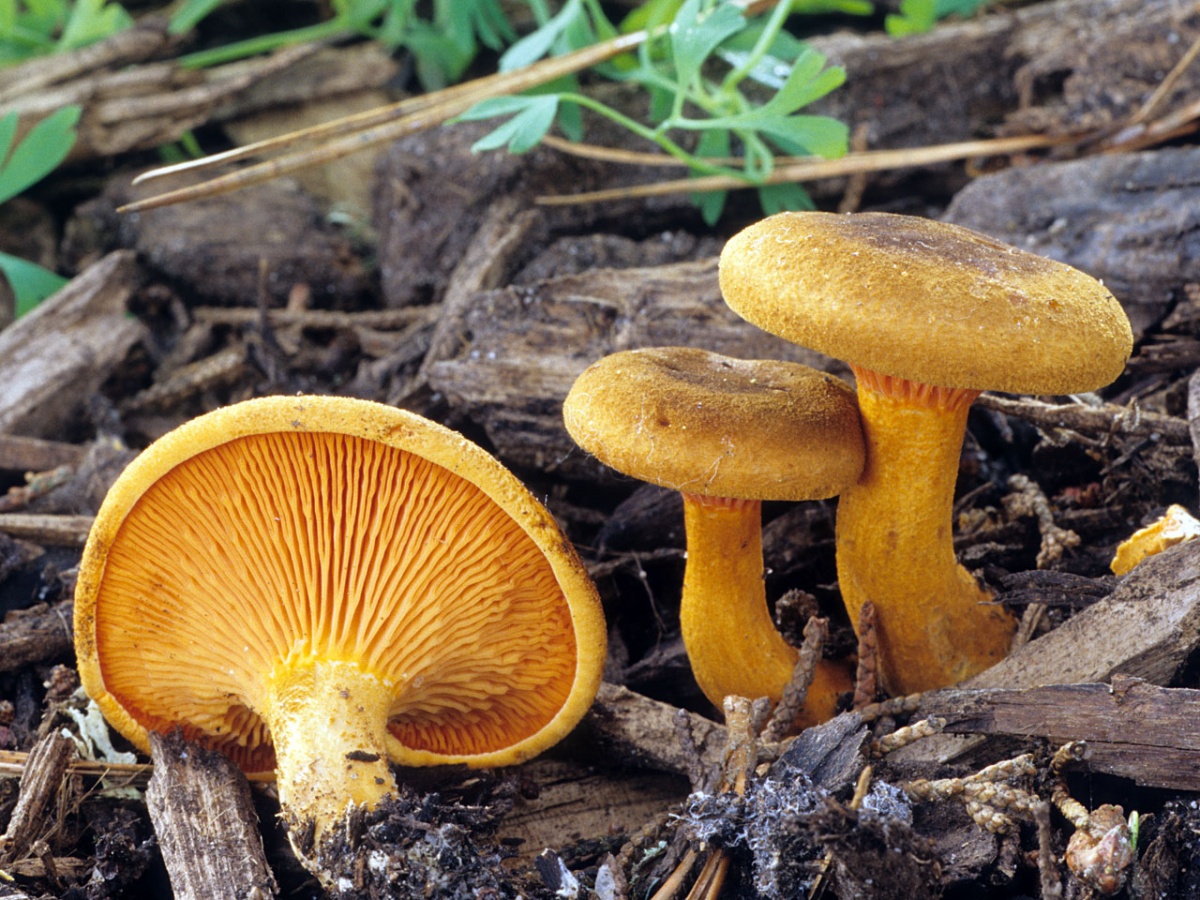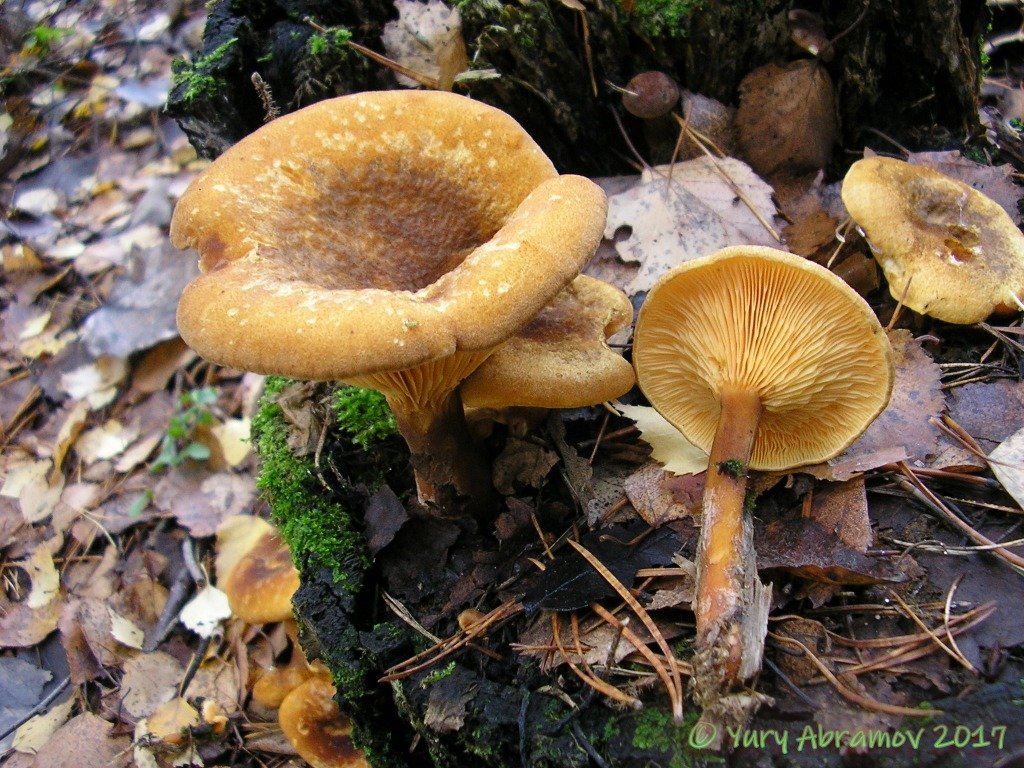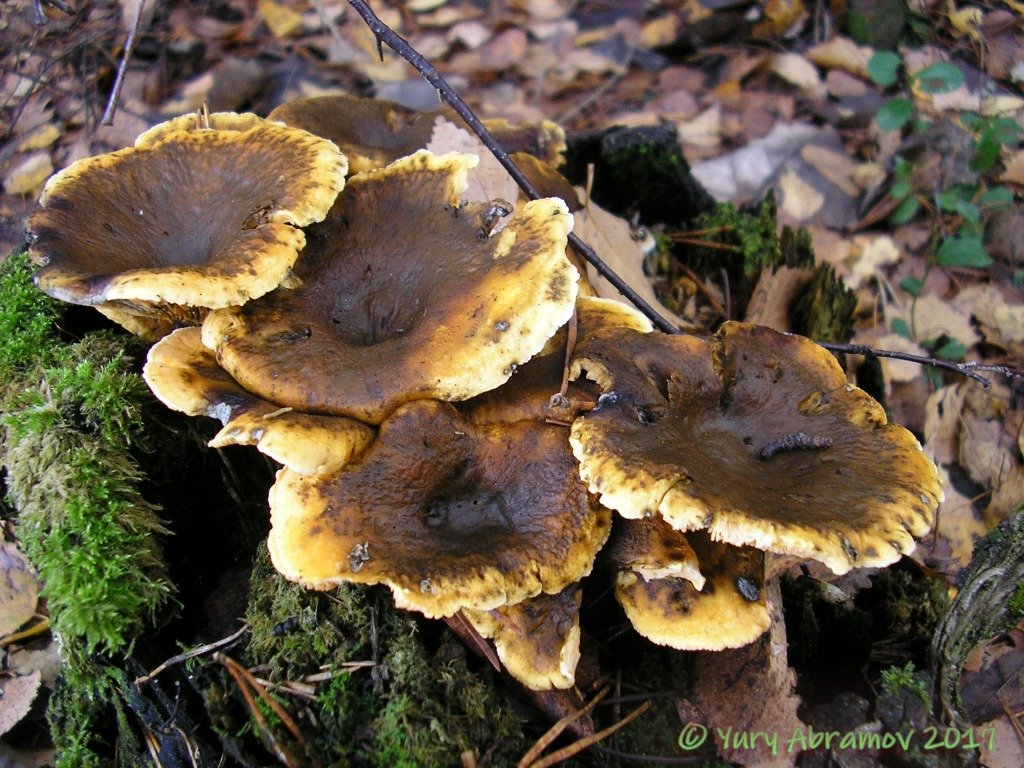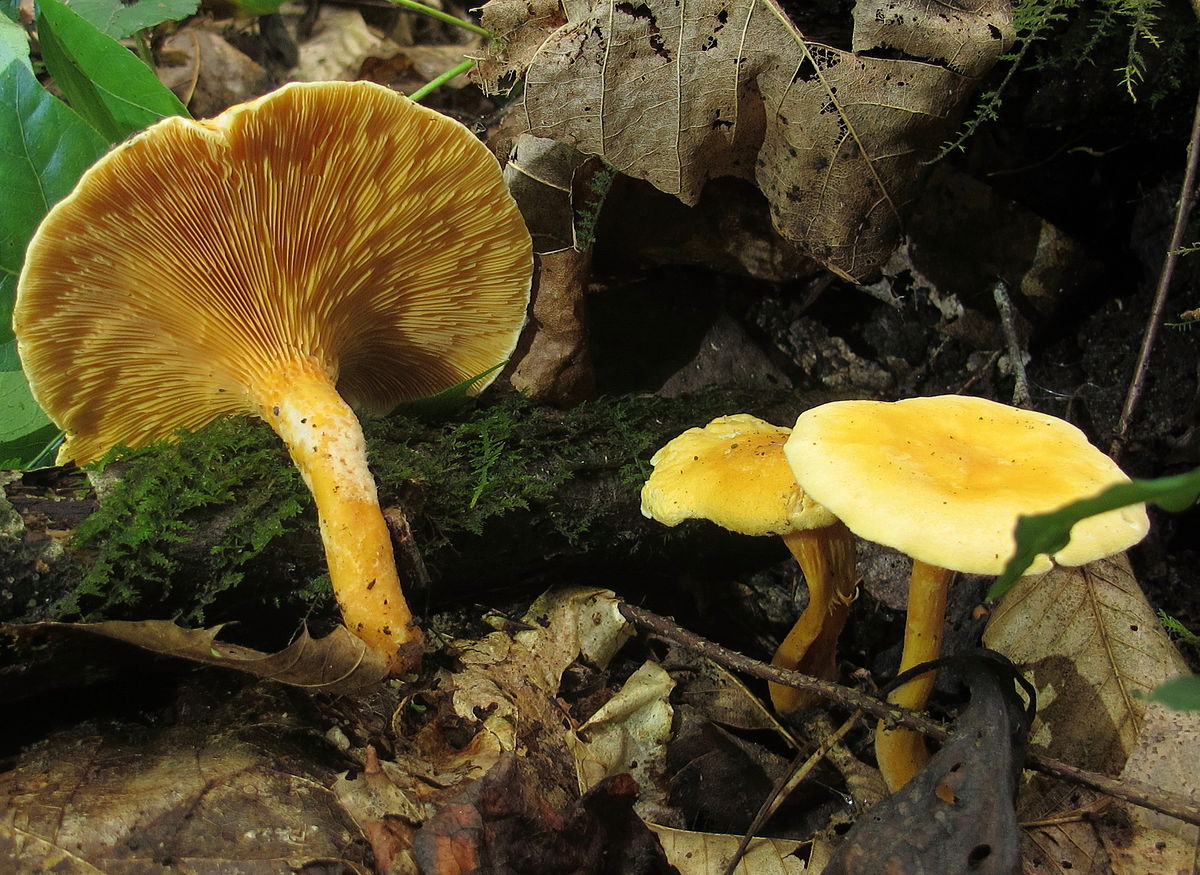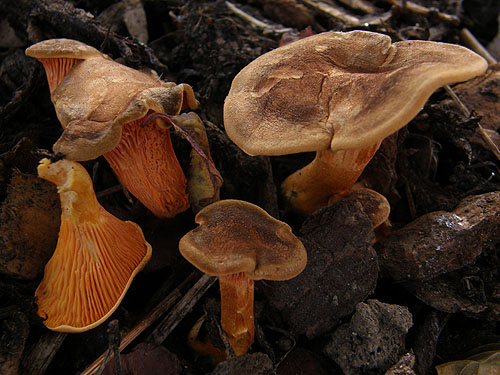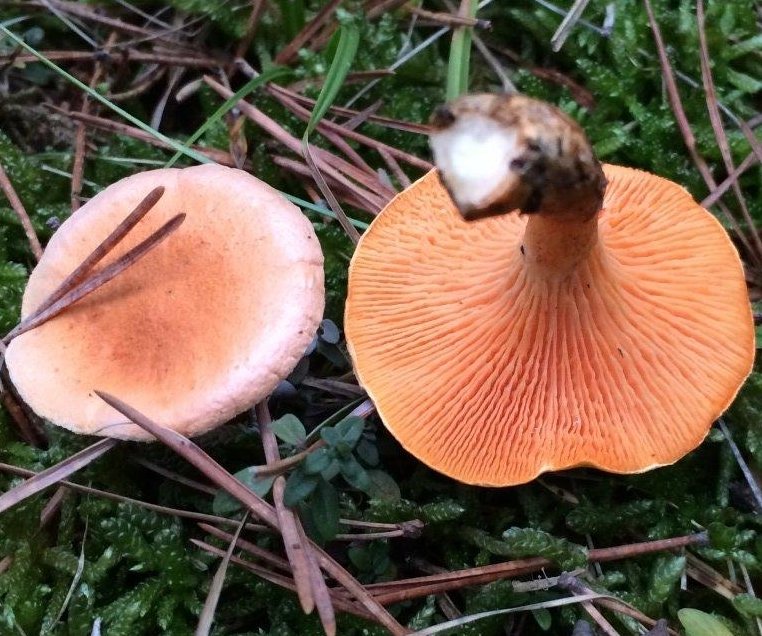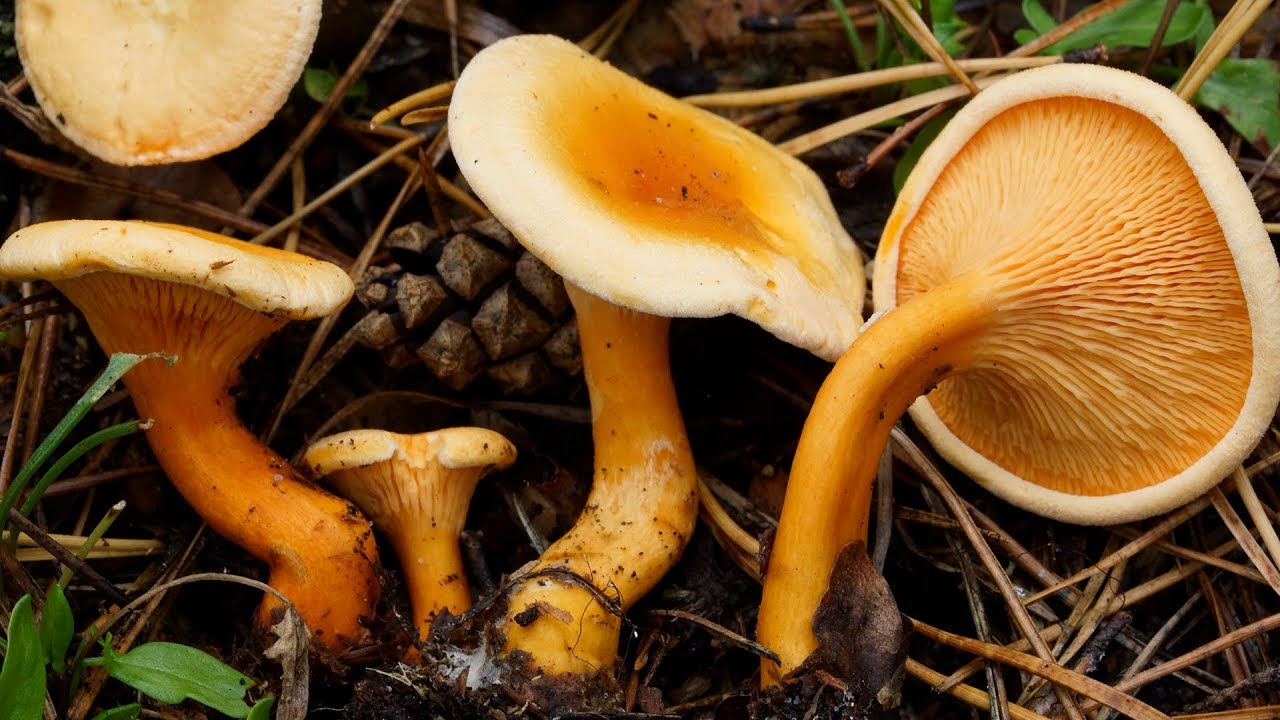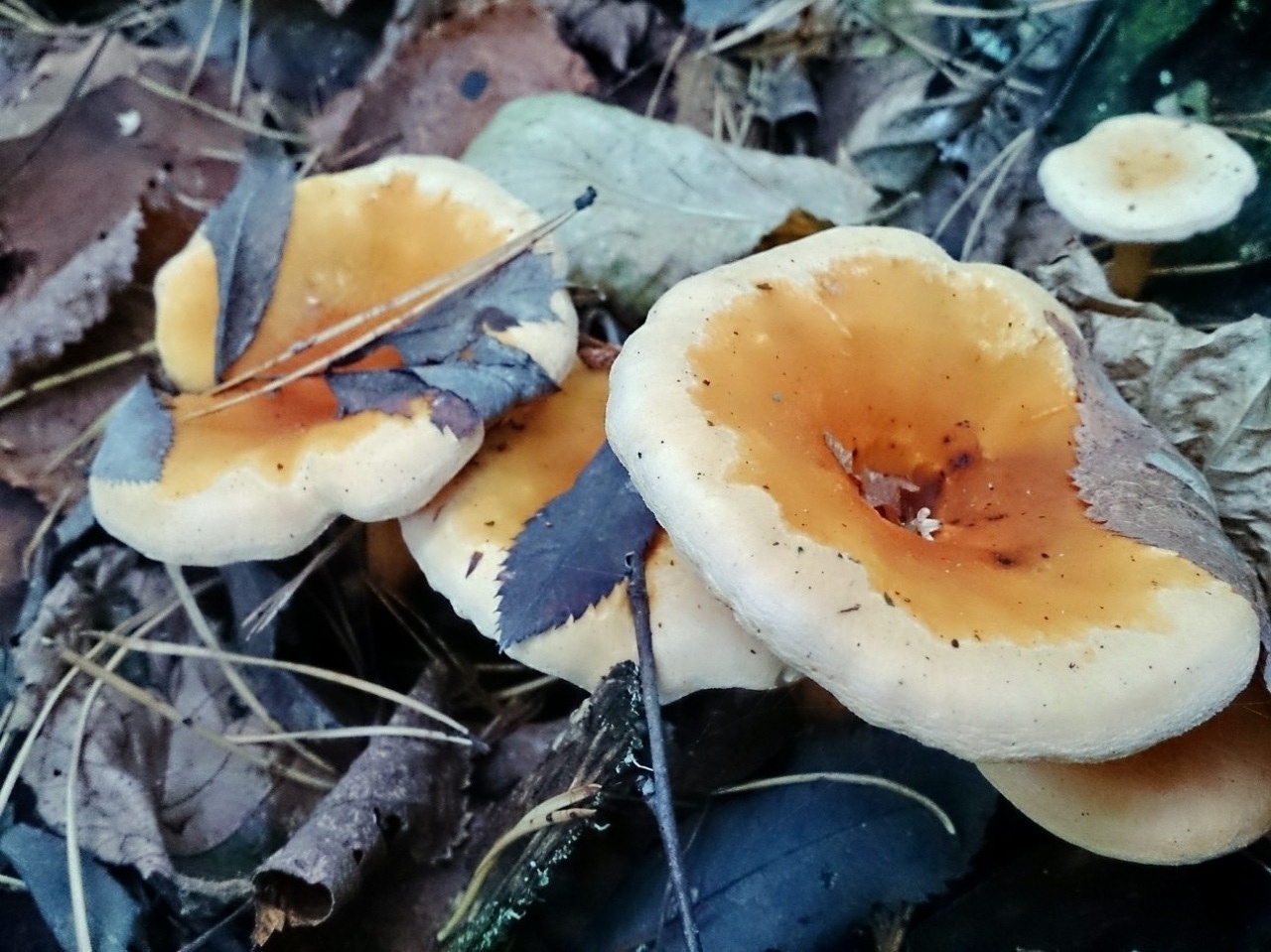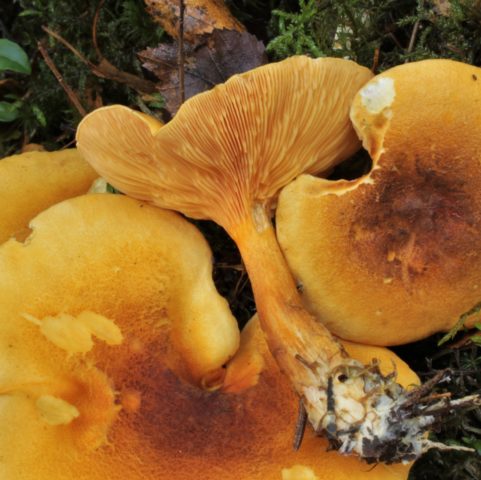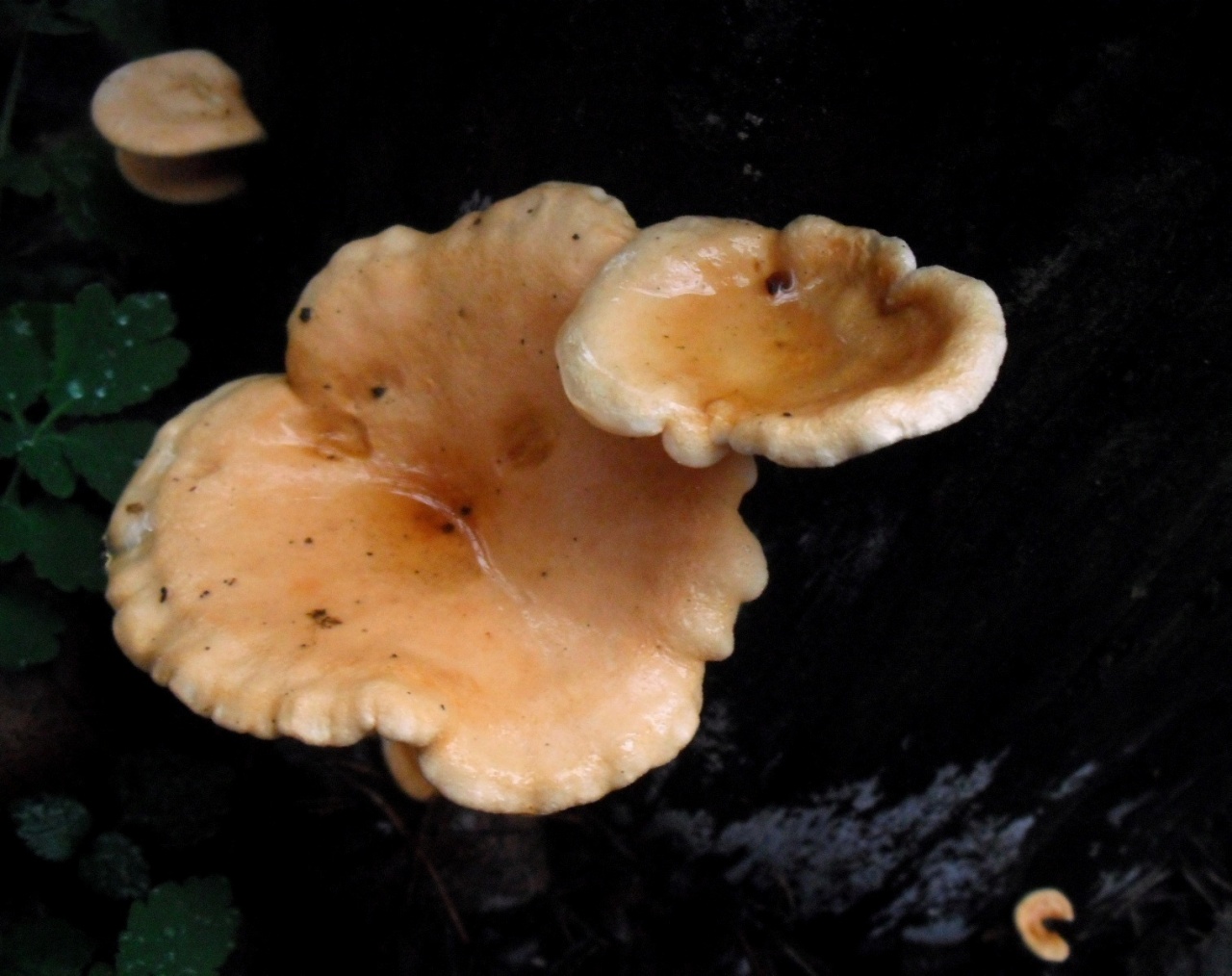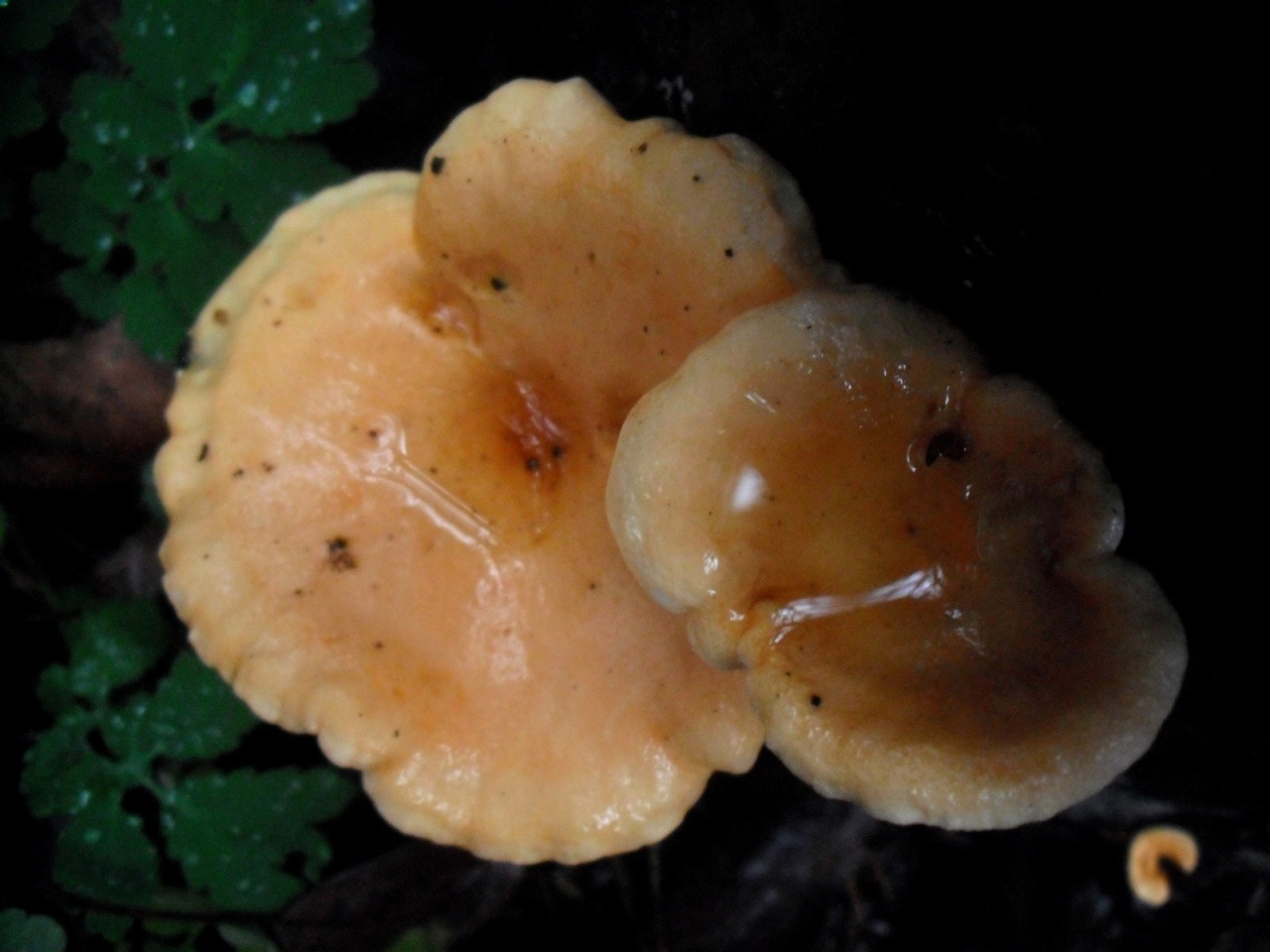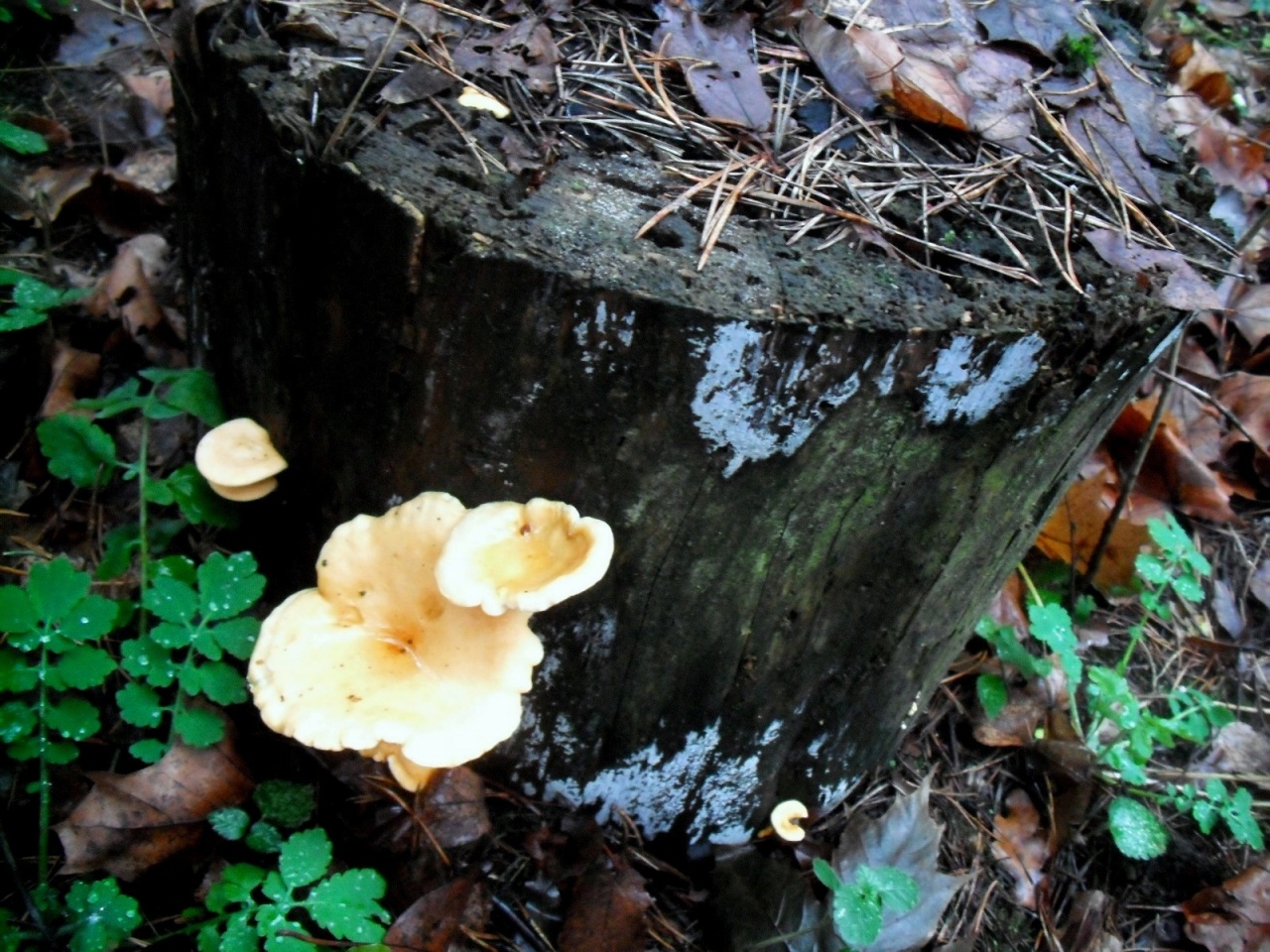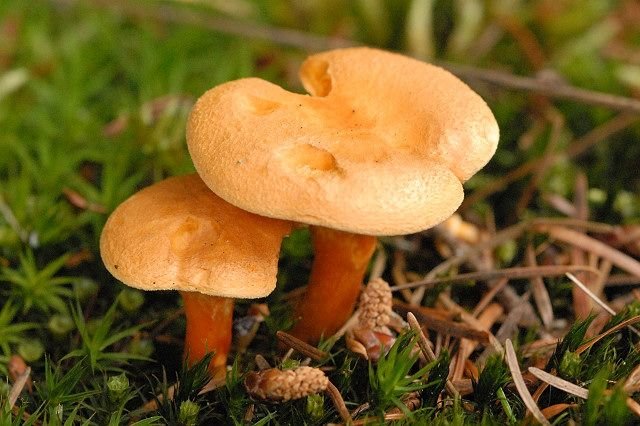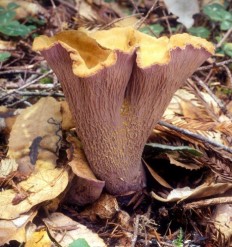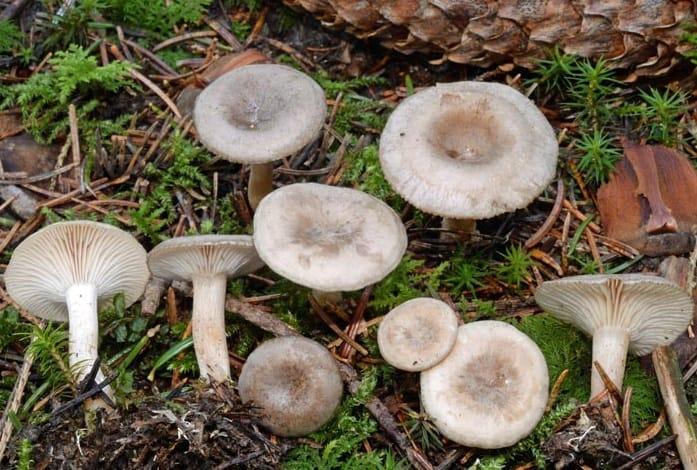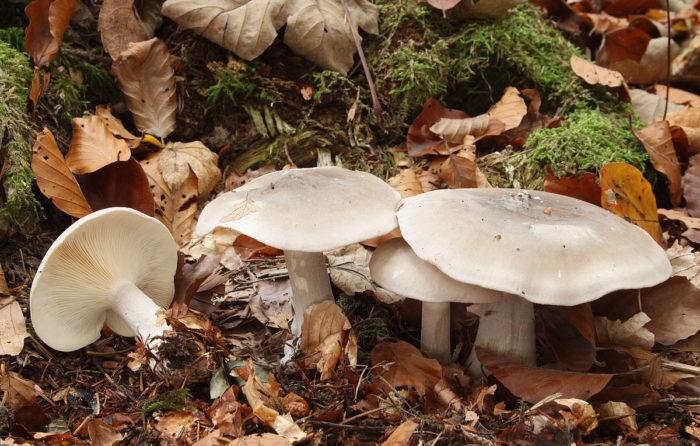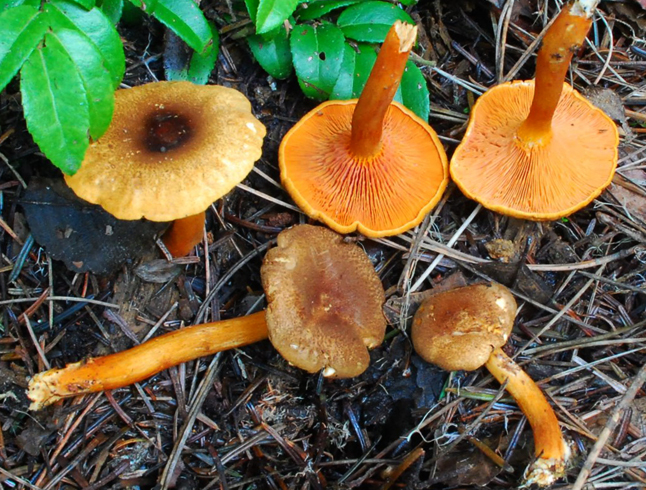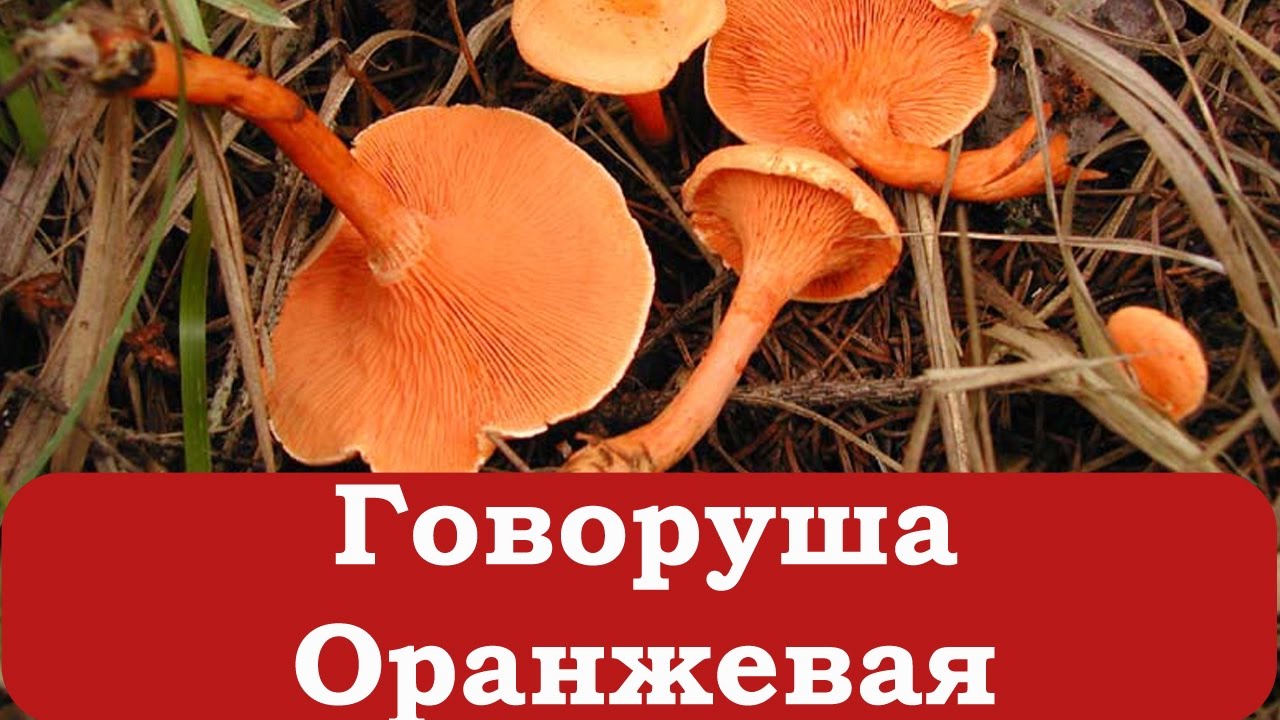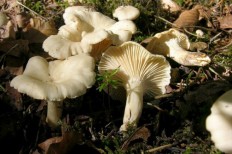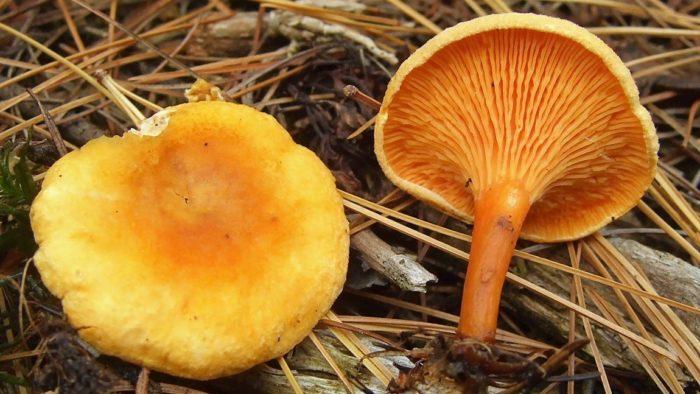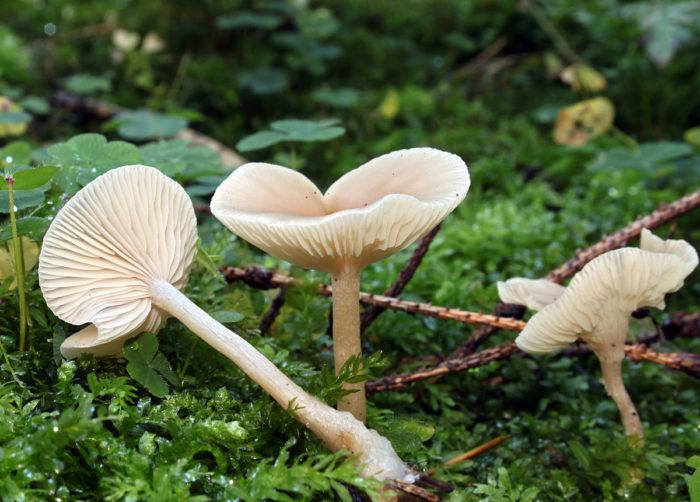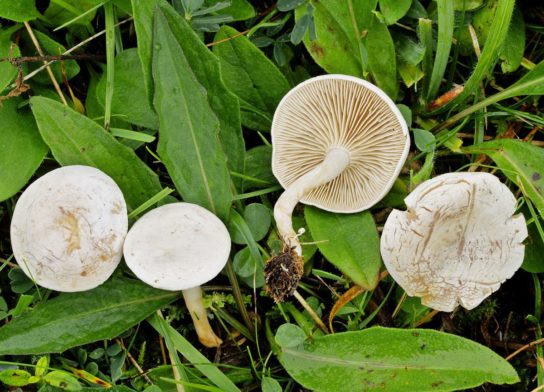The difference between the dangerous Gigroforopsis and edible twins
The talker has a similar double - the common chanterelle. From her noble sister, she differs in graceful and equally rounded forms of a hat, longer and often fused at the base of the legs. But the most important thing is the “correct” (real) plates in the cap, in contrast to the forked pseudo-plates in the common chanterelle.
 Common chanterelle
Common chanterelle
However, among the talkers there are also poisonous species. Below we list all three categories of mushrooms.
Edible talkers: funnel-shaped (Clitocybe gibba), smoky white (Clitocybe robusta), winter (Clitocybe brumalis).
 Funnel talker
Funnel talker
 Winter talker
Winter talker
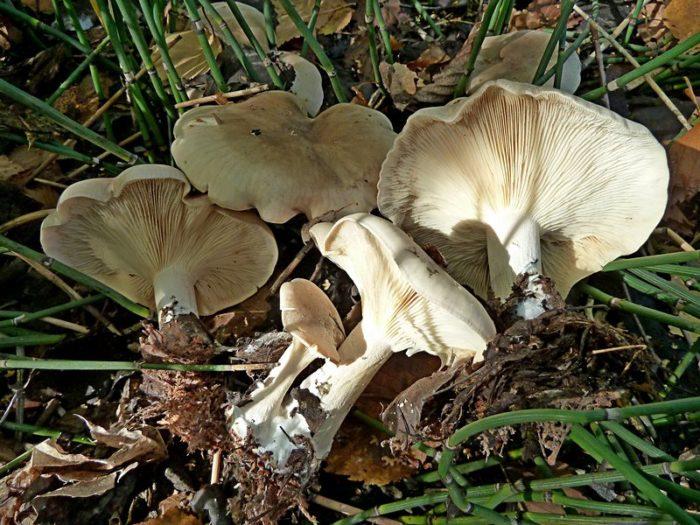 Talker smoky form white
Talker smoky form white
Conditionally edible govorushki: anise (Clitocybe odora), fragrant (Clitocybe fragrans), goblet (Clitocybe cyathiformis), clavapoded (Clitocybe clavipes), smoky (Clitocybe nebularis), orange (Clitocybe aurantia or red), warped Clitocybe pruinosa), giant (Leucopaxillus giganteus).
 Mace-footed talker
Mace-footed talker
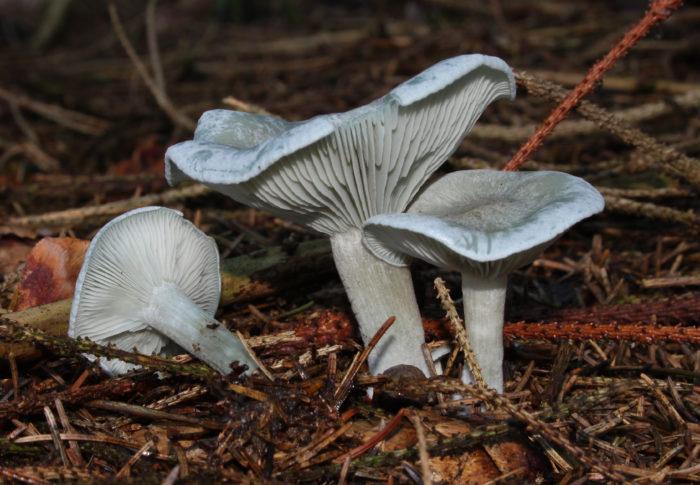 Anise talker
Anise talker
 Fragrant talker
Fragrant talker
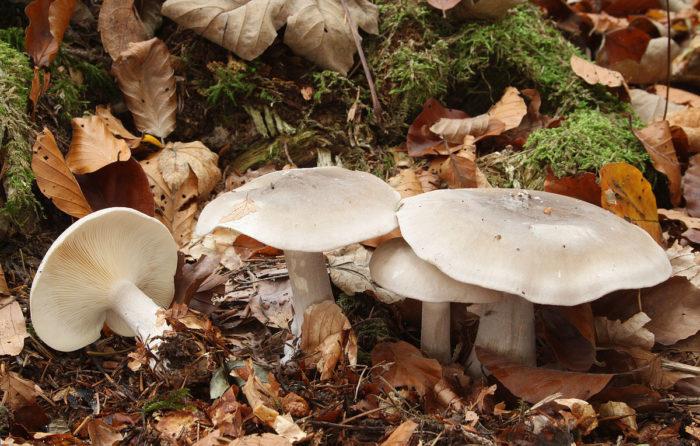 Smoky talker
Smoky talker
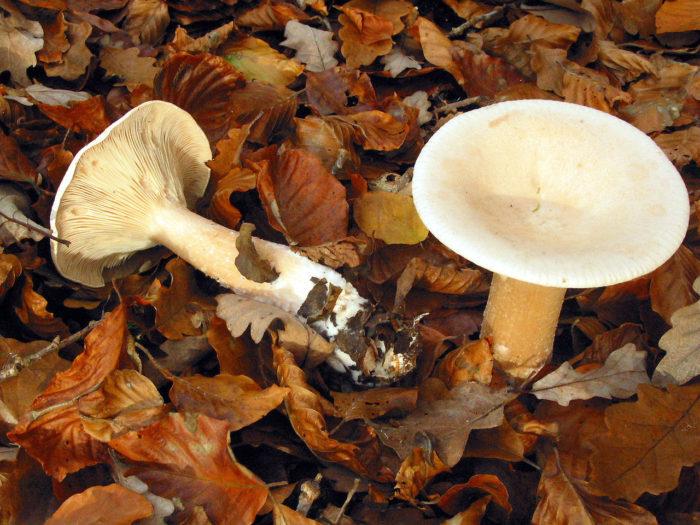 Bent talker
Bent talker
Orange talker
 Snow talker
Snow talker
 Giant talker
Giant talker
Poisonous talkers: whitish (Clitocybe dealbata), reddish (Clitocybe rivulosa), waxy (Clitocybe cerussata), gray (Clitocybe vibecina), brindle (Tricholoma pardinum), brown-yellow (Clitocybe gibilic), grooved phylophila), inverted (Clitocybe inversa), low odor (Clitocybe ditopa), translucent (Clitocybe diatreta).
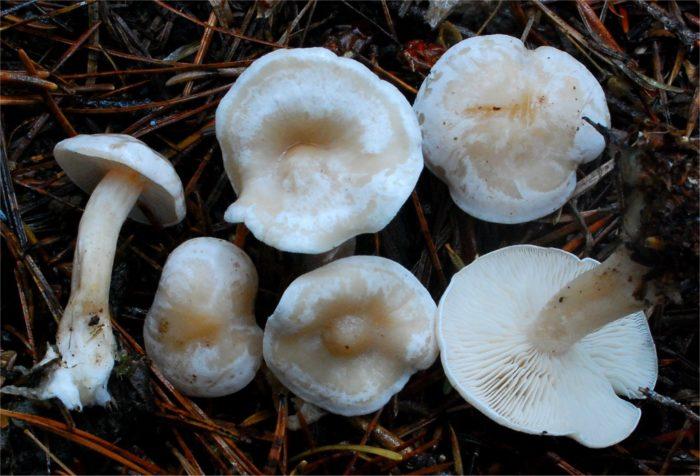 Whitish talker
Whitish talker
 Waxy talker
Waxy talker
 The talker is reddish
The talker is reddish
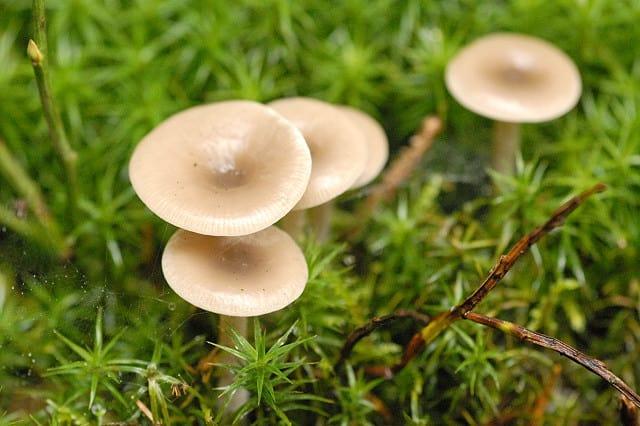 Greyish talker
Greyish talker
 Brown-yellow talker
Brown-yellow talker
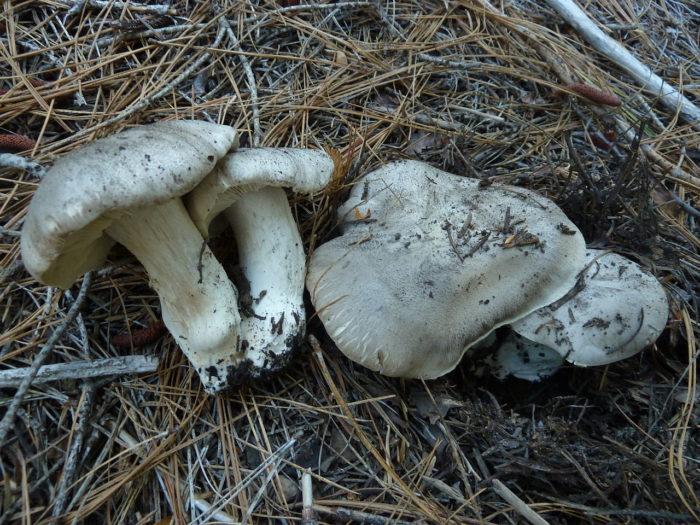 Tiger row
Tiger row
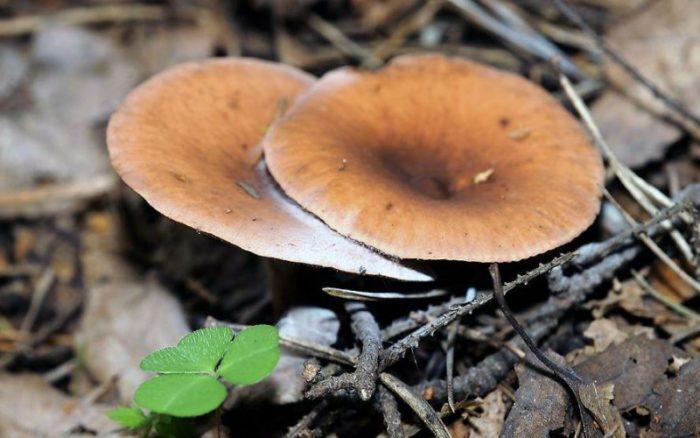 Inverted talker
Inverted talker
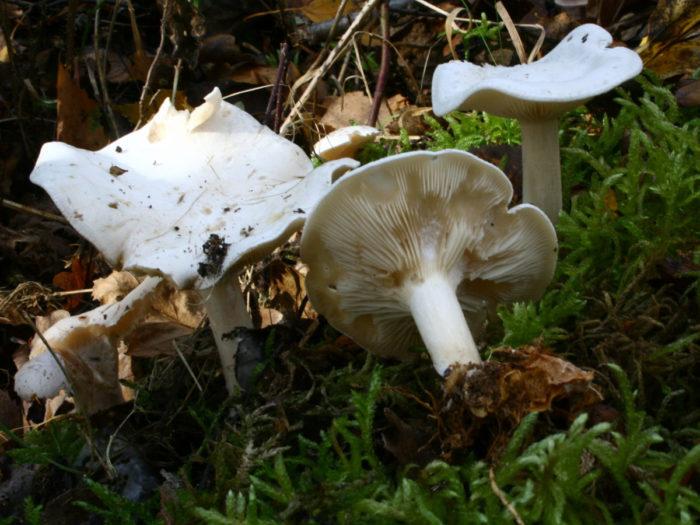 Deciduous talker
Deciduous talker
 Grooved talker
Grooved talker
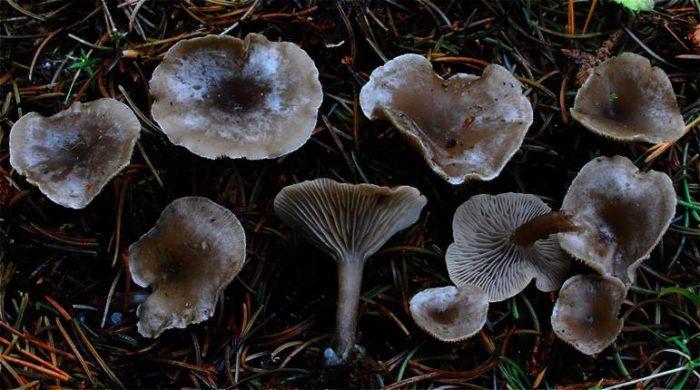 Inverted talker
Inverted talker
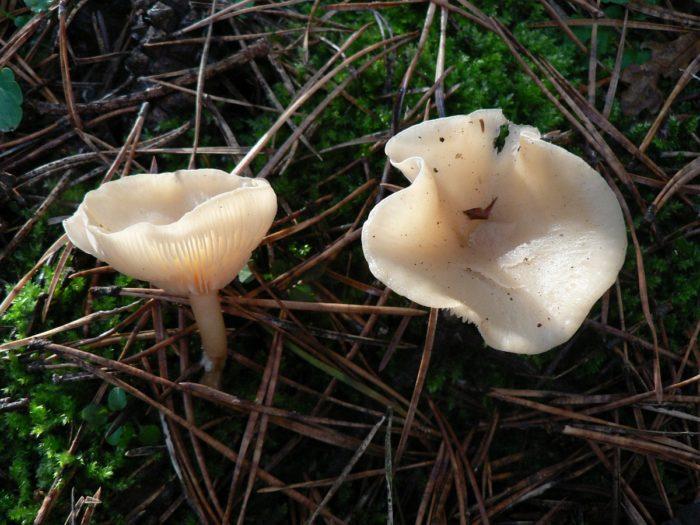 Translucent talker
Translucent talker
If you have any doubts about determining the species of mushrooms or it is difficult for you to distinguish them, then it is better not to put such specimens in the basket. Photographs of poisonous fruits will help you recognize danger during a quiet hunt.
Description of the varieties of talkers:
- Anise (Clitocybe odora). It is also called odorous or scented. A very large cap - up to 10 cm. The color is bluish or greenish gray.
- Whitish (Clitocybe candicans). A hat of the corresponding color, up to 6 cm in diameter. Poisonous.
- Fragrant (Clitocybe fragrans). The hat is gray or fawn, up to 6 cm in diameter. Conditionally edible.
- Pale or gray (Clitocybe metachroa). The hat is brown or ash shade, up to 5 cm in diameter. It has an unpleasant odor. Poisonous.
- Goblet (Clitocybe cyathiformis). Hat with a deep funnel, up to 8 cm in diameter. Conditionally edible.
- Clubfoot (Clitocybe clavipes). The hat is brown, up to 8 cm in diameter. Conditionally edible.
- Brown-yellow (Clitocybe gilva). The cap is yellow in color with small spots, 6–10 cm in diameter. Has an aniseed scent. Poisonous.
- Funnel-shaped (Clitocybe gibba). Hat up to 8 cm in size, with a funnel. Edible.
- Waxy (Clitocybe cerussata). The hat is white, up to 10 cm in diameter. Poisonous.
- Smoky (Clitocybe nebularis). The hat is ash-colored with a yellowish tinge, up to 15 cm in diameter. Conditionally edible.
- Smoky white form (Clitocybe robusta). The hat is of the appropriate color, its size is up to 20 cm. Edible.
- Grooved (Clitocybe vibecina). The hat is brown, up to 5 cm in diameter. It is rare. Inedible.
- Winter (Clitocybe brumalis). Brown hat, up to 5 cm in diameter. Edible.
- Cash (Clitocybe phylophila). The hat is white, up to 10 cm in diameter. Poisonous.
- Orange (Clitocybe aurantiaca). Red-colored hat, up to 5 cm in diameter. Conditionally edible.
- Inverted (Clitocybe inversa). Orange hat with rusty patches, up to 8 cm in diameter, with a wide funnel. Poisonous.
- Bent, or red (Clitocybe geotropa). Hat of the corresponding color, depressed shape, up to 20 cm in diameter. Conditionally edible.
- Low odor (Clitocybe ditopa). The hat is beige with a wax coating, up to 6 cm in diameter. Inedible.
- Snow (Clitocybe pruinosa). The hat is gray-brown, up to 4 cm in diameter. Conditionally edible.
- Giant (Leucopaxillus giganteus). The hat is white, up to 30 cm in diameter. It grows in August – October. Conditionally edible.
- Translucent (Clitocybe diatreta). The hat has a nut shade. Poisonous.
What mushrooms look like a false chanterelle
Omphalot olive (Omphalotus olearius)
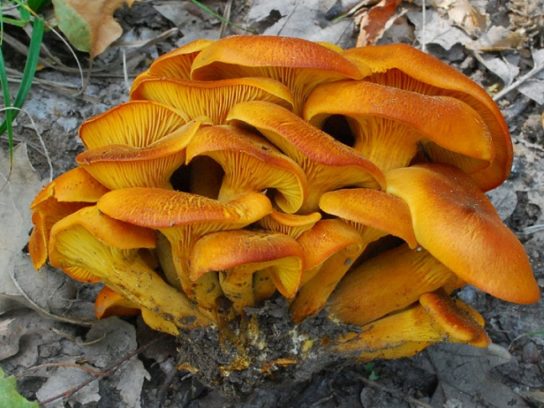
The mushroom is widespread in late summer and autumn in the southern regions of the country. It is characterized by a vibrant pumpkin orange color and a massive Halloween appearance.The mushroom follows the theme of the holiday and exhibits a glow known as bioluminescence - the production of light by a living organism - in this case, a mushroom.
A poisonous analogue of the conditionally poisonous false chanterelle grows in large clusters around:
- foundations of dead deciduous trees;
- buried roots;
- stump.
The yellow-orange or orange cap is convex at first, then becomes flat, in overripe specimens it is funnel-shaped with the edge turned down. Under the cap are narrow, straight (running down the stem) gills of the same color with a pale orange thick stem.
Omphalots olive are attractive in appearance and have a pleasant smell, but POISONOUS! They are sometimes mistakenly eaten by people who consider these mushrooms to be chanterelles, which:
- have the same color;
- found at about the same time of the year;
- eaten.
However, chanterelles:
- smaller in height;
- have not very well developed gills (more like veins);
- grow on soil, not wood.
Symptoms of poisoning: many hours of abdominal pain and vomiting, then the person begins to feel better.
Yellow Heron's Man (Hydnum repandum) and Umbilical Hern's Man (Hydnum umbilicatum)

Close relatives of chanterelles, and their scents are strikingly similar. Yellow Hericiums are found in abundance from mid-summer to late autumn. Unlike false and true chanterelles, these fungi are not eaten by insects. Hericium yellow grows around hardwoods such as birch or beech (and others).
Hericium umbilical is found under conifers and in more humid areas during the same time period, but mainly in September and October. It differs from the false chanterelle - the underside of the cap covered with teeth. In false chanterelles, under the gill cap.

Both types of counterparts of false chanterelles are prepared in a similar way. They:
- fried in a pan;
- deep-fried;
- dry.
The texture of the pulp is crispy. The taste and smell are somewhat chanterelle-like.
Comparison of real and false chanterelles
Every lover of collecting forest gifts should know what a false chanterelle looks like. To determine the differences, it is necessary to familiarize yourself in detail with each of the types. Such varieties of chanterelles as tubular, gray, white and others do not have twins, but an ordinary cockerel can be confused with an orange talker.
The chanterelle is real
False chanterelle
Despite the fact that edible and false specimens are very similar, an experienced mushroom picker can easily tell them apart. This is where a simple tip from a seasoned forest lover comes in handy. In spite of what are these delicious mushrooms, it should be remembered that they have twins. I'll tell you how I define chanterelles: you can focus on the color of their hats and the shape of their legs. So, everyone's favorite bettas are distinguished by a muted reddish color.
The surface of their cap is matte, always smooth, the skin almost does not separate from the pulp - thick, juicy, corresponding to the shade of the leg. Sometimes the flesh of the mushroom can be very light, almost white. When broken and pressed, it turns slightly red.
The edges of the cap at a young age are smooth, neatly rounded. As they grow, they bend beautifully, become wavy at the edges, and the fruit body acquires a slightly funnel-shaped shape with a deepened center.
A real chanterelle is capable of growing to a large size. Often there are specimens with a cap diameter of about 10-12 cm.
Chanterelle mushrooms have a thick and strong stem. It expands at the top and merges smoothly into the cap. The color of the fruiting body does not change throughout, it has uniformity. The leg thickness is from 10 to 30 mm, the length is up to 7 cm. It is slightly lighter than the cap.
Males do not have plates, the hymenophore consists of frequent, highly branched folds that descend to the pedicle, making up one whole with it.
The color of the caps of the false chanterelle is brighter than that of the real ones. So, when collecting gifts from the forest, the mushroom picker should be alerted by the yellow or orange, slightly velvety surface of the specimen encountered.The diameter of the cap of the kokoshka does not exceed 6 cm, the plates descend to the stem. They are frequent, thin, bright. The pulp is white or yellow, with a sharp mushroom odor (if the aroma is sweetish, then this also indicates that the specimen belongs to the genus Gigroforopsis).
A pronounced difference between these mushrooms is that they have a rather thin (up to 10 mm) and long (up to 5 cm) stem. It is flat, but rarely curved. Inside - fibrous, with pulp resembling cotton wool. The color of the flesh of the leg does not match the shade of the cap; at the base it is darker (almost black).
Key differences
So, you need to remember the difference between representatives of two types of eukaryotes. They are as follows:
- False chanterelles have a brighter color. Cockerels have a calm reddish tone.
- If the mushroom has a sour taste, and its leg is thick and smoothly turning into a cap, then this is an ordinary chanterelle. Such a mushroom has a slightly curved leg shape. Kokoschki have a thin and hollow stem.
- The chanterelle mushroom grows in large colonies, the kokoschka - almost always single specimens. It can be found on fallen and rotting tree trunks.
- All kinds of worms and larvae are very fond of eating false chanterelles, while cockerels are extremely rarely spoiled by insects. The only worm that can be found when cutting the fruit body of a cockerel is the wireworm. This fact is explained by the presence of a large amount of chitinmannose in the fruiting bodies of common chanterelles.
- Another difference is that false eukaryotes have an easily peelable skin. When it is removed, the rough surface of the cap is exposed. It is almost impossible to peel off the skin of cockerels.
- In orange talkers, the color of the plates is brighter than the tone of the cap, while in roosters it is uniform and uniform over the entire surface.
These are the main characteristics that show how one species differs from another.
Is it possible to eat false chanterelles
Some inexperienced mushroom pickers are afraid to collect real chanterelles, explaining this by the presence of their poisonous counterparts in the forest. But you need to know that the orange talker is a conditionally edible mushroom. That is, with proper heat treatment, it does not always harm the body.
According to experts, in order for a person to receive a slight poisoning, it is necessary to eat a fairly large number of talkers. It is difficult to do this, since the false mushroom stands out from the real one with an unpleasant taste. In addition, cocks differ from cockerels and a specific smell. Therefore, in the process of preparing forest gifts, every housewife will be able to recognize the species of eukaryotes.
Characteristics and a brief description of the structure of the edible mushroom
The common chanterelle mushroom differs from the rest in its pure pulp without wormholes and parasites, it emits the aroma of dried fruits with roots. Its leg merges smoothly into the cap, the diameter of which varies from 1 to 20 cm, depending on the season. The color of the fungus varies from light yellow to yellow-orange. Therefore, he was given another name - yellow chanterelle mushroom.
Hat
Its shape depends on the maturity of the mushroom. In unripe fruits, it is convex, like a ball. Almost ripe chanterelles have a concave-flat cap with a depression in the center. In overgrown mushrooms, it is funnel-shaped. To the touch, its surface is soft, velvety, the skin does not separate from the pulp. The edges of the chanterelles are always wrapped and have wavy shapes.
Hymenophore
The hymenophore is the lower (inner) part of the cap, or the spore-bearing layer. It consists of wavy folds that go to the leg. Often it looks like forked-branched veins, rather thick and rare (less than ten per 1 cm).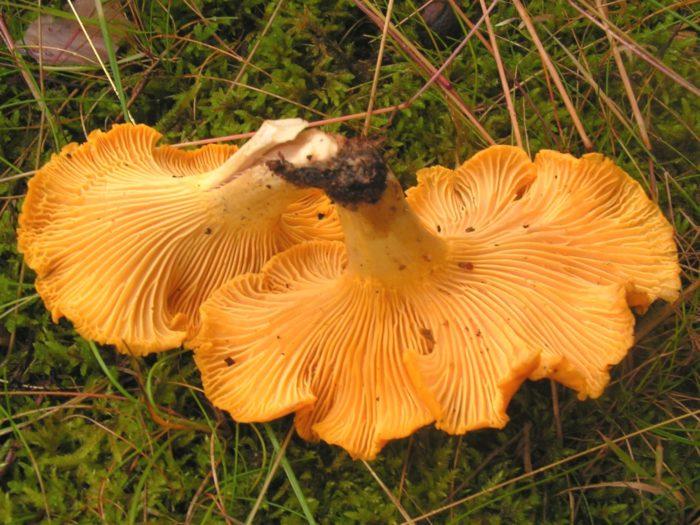
Cut pulp
Dense, fleshy, fibrous on the stem. The cut edges are yellow. The color gradually changes to whitish in the center of the cut. It tastes sour. When pressed, it turns slightly red.
Leg
The leg smoothly passes into the cap, gradually expanding. Its lower and central part is smooth, without veins.The root is often curled up because the base of the stem is narrower. The thickness ranges from 0.5 to 3.5 cm. The length ranges from 1 to 10 cm. The color is similar to the color of the cap, but often in less saturated tones.
A bit of history
For the first time, the real chanterelle was described by Doctor of Sciences Karl Linnaeus in 1753. He gave her the definition of Agaricus chantarellus for a lamellar structure in the form of a wine bowl. Later, in 1821, thanks to Elias Magnus Fries, the mushroom got the name that is still used today - Santharellus cibarius. Latin translates this designation as something edible, valuable, food.
Poisoning symptoms
If there has been a poisoning by chanterelles, then the deterioration will occur in the period from 30 minutes to 3 hours after accepting the gifts of the forest for food. Often, symptoms and signs of poisoning appear only the next day. The term depends on the number of talkers eaten, on the time spent on processing them. The age of a person and the presence of chronic diseases in him are of great importance.
If the chanterelles turned out to be poisonous, then the symptoms of poisoning will be as follows:
- pain in the epigastric region;
- weakness;
- severe nausea;
- repeated vomiting;
- diarrhea (less often constipation).
If bacteria enter the thermally processed product, the symptoms will be supplemented by an increase in body temperature. The intensity of the signs depends on both the toxicity of the fungus and the type of microbes that caused the disorder.
When botulism occurs, which can disguise itself as poisoning by chanterelles, the following will appear:
- sudden visual impairment (double vision, fog, blurring);
- muscle weakness;
- dry mouth.
The use of poisonous mushrooms can be accompanied by increased salivation, sudden surges in blood pressure, constriction or dilation of the pupils.
In all cases, you should immediately seek medical attention.
Despite the benefits and composition, which includes a large amount of substances necessary for the human body, real chanterelles and their counterparts (false) are considered mushrooms that are difficult to digest. This is due to the presence in the pulp of the first chitin, and the second - toxic substances. Eating even a small amount of this product can cause discomfort in people suffering from pathologies of the gastrointestinal tract and enzyme deficiency. In severe cases, undigested fungi can clog the intestines, requiring urgent medical attention.
First aid for chanterelle poisoning
Even if a person is not afraid of mushroom poisoning and believes that the product was of high quality, if negative symptoms occur after eating chanterelles, you need to call an ambulance.
Before her arrival, the following measures are required:
- Perform a gastric lavage by drinking 4-5 glasses of warm boiled water and pressing on the root of the tongue with the handle of a spoon to induce vomiting. The procedure is repeated until the vomit becomes transparent.
- Cleanse the intestines with an enema with warm boiled water.
- Drink 10-15 tablets of Activated Carbon, 1 sachet of Enterosorb or 1 tbsp. l. Enterosgel. The latter must be dissolved in half a glass of warm water.
- Take 20 g of a salt-based laxative (Magnesia sulfate, Salt Barbara).
- Drink plenty of clean drinking water.
In most cases, poisoning with an orange talker is not difficult, and stabilization of the state can be achieved quickly enough.
False doubles
The false chanterelle is the most common double chanterelle. It belongs to conditionally edible mushrooms, but it is highly undesirable for consumption due to a possible severe disorder of the digestive system. Take a look at the following photo for comparison. The difference between false and real chanterelles is obvious. You can distinguish an inedible mushroom by its orange color and the shape of the cap. In a false chanterelle, its edges form a circle, which is bent under the hymenophore.And the top of the cap is slightly raised, with a conical seal, like a toadstool, which differs from the concave shape of the edible counterpart.
 False chanterelle
False chanterelle
Hericium yellow is also edible and is often confused with chanterelle. If you look at the photo, you will notice three main differences. The leg is thicker and widens downward. The color of the cap is pale, milky yellow, as if faded. And the hymenophore does not have folds at all. Instead, there are small soft milky thorns.
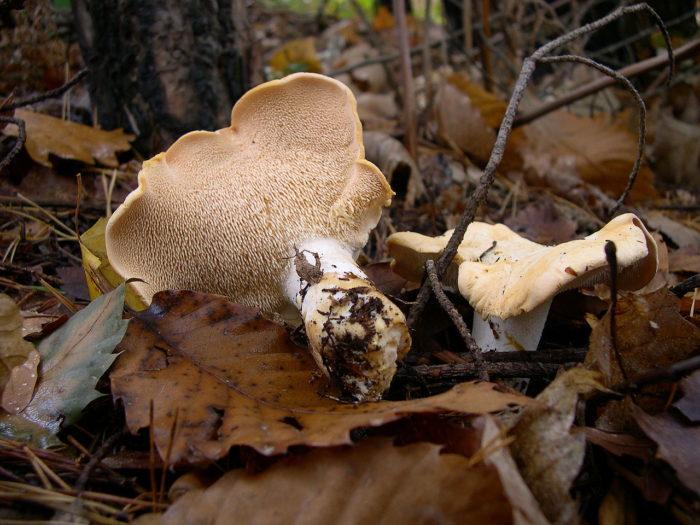 Hericium yellow
Hericium yellow
Red talkers can also be confused with chanterelles, which is undesirable, because they have different food processing methods. The photo shows their features. The hat is reddish-brown, dry, thin, the edges are even and not rounded. The flesh on the cut is white, and the hymenophore plates are thin and almost invisible.
 Talker
Talker
Dangerous doubles
Poisonous False Chanterelle, Hygrophoropsis aurantiaca. Similar in color, place of growth, hymenophore. Fruiting on tree stumps, felled trees and tree litter. The color of the cap is pinkish-beige, dark yellow with wormholes. The hymenophore is like a sponge.
 Hygrophoropsis aurantiaca
Hygrophoropsis aurantiaca
Omphalot olive, Omphalotus olearius. Similar in fruit color, smell and place of growth. It settles on wood dust in tropical climates. It has a cap that is darker in color than the chanterelle. The pulp is brittle, gives off a very unpleasant odor.
 Omphalotus olearius
Omphalotus olearius
Evaluation of taste, medicinal properties, benefits and possible harm
The taste of mushrooms is specific. They have a sour tint and can taste bitter if cooked improperly. In Europe, this product is practically not eaten.
But the Russians attribute special medicinal properties to chanterelles. They are believed to be: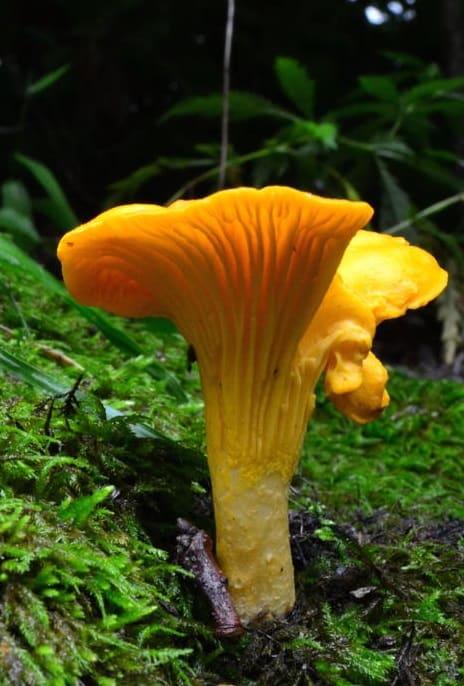
- strengthen nails, hair and improve skin condition, because they contain 8 essential amino acids;
- help the body with hepatitis C, because they include trametonolinic acid;
- effective in the fight against anemia, since they contain a lot of iron and vitamin C. 300 g of the product, when fully absorbed, provide the body with a daily norm;
- useful for colds, are natural antibiotics, fight against tubercle bacillus;
- effective in the fight against parasites and worm eggs (chitin mannosis);
- restore vision and resist tumor diseases (vitamins, minerals);
- treat the pancreas and liver (in the form of substances for alcohol).
The advantage and benefit of this product is determined by the general effect on the body:
- anti-inflammatory;
- bactericidal;
- immunostimulating;
- anthelmintic;
- restoring nerve connections.
There are no special contraindications
With caution, you should take various kinds of tinctures (vodka, alcohol, acids) and decoctions from chanterelles. It is worth limiting the use of people who have a disease of the digestive organs, as well as children under 5 years old
Poisoning: symptoms, first aid
False chanterelle contains toxins that affect the functioning of the stomach, intestines, liver, and kidneys. Even pre-processed mushrooms can cause poisoning, and those that have not gone through the soaking and boiling procedure are guaranteed to cause it.
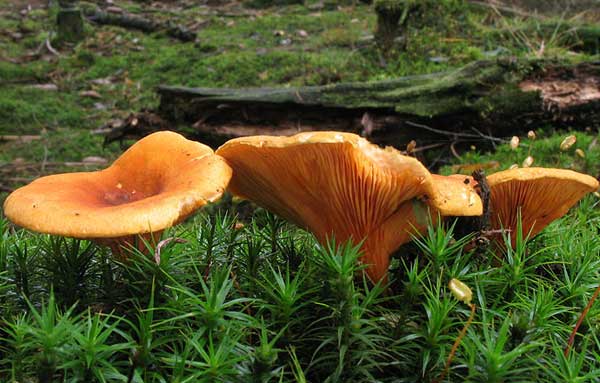
Symptoms of poisoning appear approximately 30 minutes after toxins enter the body; depending on the general condition and age, this time can increase up to 3 hours. If a small amount of toxins are ingested, they can show their harmful effects in a day.
Among the symptoms of poisoning with false chanterelles, the most common are:
- weakness;
- loose stools;
- stomach pain, vomiting.
The main danger of these fungi is that pathogenic bacteria, including those that cause botulism, often settle on them. As you know, high temperature does not destroy them, but, on the contrary, stimulates reproduction. If, in addition to fungal toxins, bacteria have entered the body, then signs of poisoning will appear much later (up to 3 days) and will be accompanied by high fever, visual impairment, and dry mouth.
If signs of poisoning appear, you should immediately seek qualified medical help. Many believe that you can "cope" with them on your own: they wash the stomach, take sorbents and drink plenty of fluids. In the case of cocoons, this is not enough, since there is a threat of the development of concomitant diseases, for example, botulism.
The false chanterelle has always been classified as an inedible, weakly poisonous mushroom. It is for this reason that novice mushroom pickers often bypass real chanterelles - in order to distinguish them, a certain skill is needed. Despite the fact that the mushroom is advised to be treated as conditionally edible, the attitude of lovers of quiet hunting has not changed. Indeed, risking health for the very dubious pleasure of trying a tasteless, fibrous, cotton-like mass is at least silly.
External description of the mushroom
The stem of the mushroom has a cylindrical shape, high density, smooth surface. Downward, the leg is slightly narrowed, and upward - it expands. Its dimensions are 3-7 * 0.5-4 cm.The diameter of the cap of the amethyst chanterelle (Cantharellus amethysteus) varies between 2-10 cm. fleshy. In mature mushrooms, the cap takes a funnel shape, a light yellow or rich yellow hue, a wavy edge, and has many plates. Initially, the flesh of the cap has a yellowish tint, but gradually turns white, becomes dry, elastic, like rubber, very dense. Taste qualities of amethyst chanterelle are characterized by high quality, slightly reminiscent of the taste of dried fruits. Lamellar veins descend from the cap down the stem. They are characterized by a yellowish color, branching, great thickness, sparse arrangement and low height. The chanterelle of the species Cantharellus amethysteus is found in two varieties, namely amethyst (amethysteus) and white (pallens).
Medicinal properties
Amethyst chanterelle has excellent medicinal properties. Its use in food helps to increase the body's resistance to colds, increase immunity, raise tone, and cope with dermatitis. The funnel-headed mushroom helps fight cancer cells and has powerful bactericidal and antiviral effects.
The fruit body of amethyst chanterelles contains a large amount of vitamins, including B1, B2, B3, A, D2, D, C, PP. This mushroom also contains trace elements in the form of copper and zinc, acids important for the body, carotenoids with an antioxidant effect.
If amethyst chanterelles are eaten constantly, it will help to improve vision performance, prevent inflammatory diseases in the eyes, and remove dry skin and mucous membranes. Experts from China also recommend including chanterelles in their diet for those who constantly work at the computer.
The composition of amethyst chanterelles and similar species contains a special substance ergosterol, characterized by its active effect on liver enzymes. Chanterelles are recommended for everyone who suffers from liver diseases, hemangiomas, hepatitis. According to recent studies, trametonolinic acid negatively affects the hepatitis virus. This polysaccharide is found in sufficient quantities in chanterelle mushrooms.
The fruiting bodies of amethyst chanterelle can be infused with alcohol, and then use the infusion for medicinal purposes, to prevent the development of cancer cells in the body. With the help of chanterelles, you can get rid of helminthic invasions. Perhaps this is due to the enzyme chitinmannose, which is one of the natural anthelmintics. An interesting fact is that in Latvia chanterelles are used to effectively cure tonsillitis, tuberculosis, and furunculosis.
Description of false chanterelle
The false chanterelle has a brighter color in comparison with the real chanterelle.Its color is most often orange with a brown tint, the edges are always lighter than the center. The surface of the cap is velvet. The color of the cap of a real chanterelle is light yellow, sometimes it can be almost white, but it can reach yellow-orange. A real chanterelle can never be as red as its counterpart. In addition, the color is the same both in the central part and at the edges, and the surface is smooth.
The edges hats of false chanterelles smooth, neatly rounded. The diameter of the cap does not exceed 3-6 centimeters. In young mushrooms, the shape of the cap is slightly convex, while in mature it becomes funnel-shaped. The edges of the caps of real chanterelles are wavy, their shape is irregular. The diameter of the cap can be up to 12 centimeters. In young true chanterelles, the cap is convex in shape, then becomes flat.
The plates of false chanterelles are thin, often located, not passing to the stem, branching, orange in color. And in real chanterelles, the plates are denser, they go down to the leg.
The flesh of false chanterelles is yellow, friable, tasteless with an unpleasant odor. If you press on the pulp, its color remains the same. In real chanterelles, the flesh is white in the middle, and yellowish at the edges, its taste is sour and has a pleasant aroma.
False chanterelles have thin, red-orange legs. In adult specimens, the legs are hollow. In the lower part, the color of the leg is darker. The shape is cylindrical. The cap is clearly separated from the leg. In real chanterelles, the legs are not hollow, they are thicker, there is no distinction with the cap, dense, smooth, narrowed downwards, of the same color as the cap. In false chanterelles, the color of the spores is white, while in the real ones it is yellow.
Where do false chanterelles grow?
These mushrooms can be found in mixed and coniferous forests. They are found on decaying wood, in moss, among dead wood. Yields peak from summer to autumn. False chanterelles can grow singly and in groups. Real chanterelles also grow in forests, but they do not inhabit old trees.
False chanterelles often grow in the neighborhood of real chanterelles. Another difference between these similar mushrooms is that worms never start in real chanterelles, which is due to the content of chitinmannose in their composition. This substance has an anthelmintic effect. Insect larvae die under the influence of this substance. In false chanterelles, chitinmannosis is not produced, so their fruiting bodies can be affected by worms.
Are False Chanterelles Poisonous or Not?
False chanterelles can be eaten, but they are not particularly tasty mushrooms. Like other conditionally edible mushrooms, false chanterelles need preliminary soaking for 3 days. In this case, in the morning and in the evening, the water must be replaced with a new one. After soaking, the mushrooms are boiled for 15 minutes. The false chanterelles can then be marinated or fried.
As a rule, experienced mushroom pickers do not pay attention to false faces, since more delicious mushrooms grow in the forest at this time. It should be remembered that in people with a weak digestive system, the use of false chanterelles can provoke a violation of the digestive process
With improper culinary processing of false chanterelles, signs of poisoning appear: nausea, dizziness, vomiting, weakness, upset stools, abdominal pain and cramps. With these symptoms, you should immediately call an ambulance.



